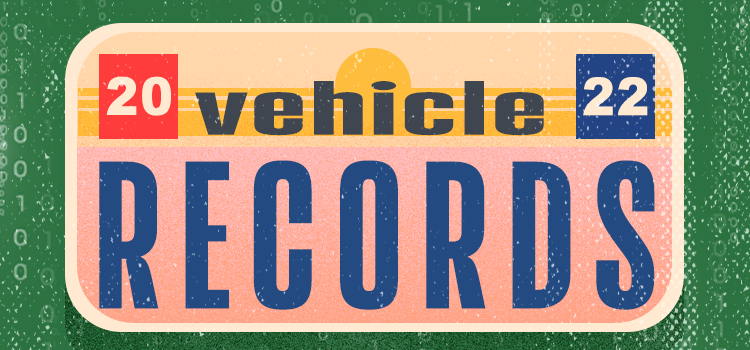February 03, 2022
Vehicle-Based OSINT Investigations Tips & Techniques

Steve Adams
Product Marketing Manager
Vehicles are intrinsically linked to our way of life, so identifying the vehicle that the subject of an investigation owns, has access to, or is in possession of, can provide valuable insight into their current location. Vehicle records can facilitate; surveillance, vehicle searches, locating missing persons and offenders, tracking stolen vehicles, and preventing physical attacks.
Vehicle records can be linked to two different unique numbers that exist for all vehicles on the road, VIN and VRM. Utilizing different internet systems, these unique numbers can be searched to bring back details including, vehicle make, vehicle model, the year vehicle was first registered, vehicle color, vehicle taxation status, and more.
VIN
A VIN, or Vehicle Identification Number, is a unique standardized 17-digit code assigned to every vehicle that is used by the automotive industry to identify individual vehicles. This code is structured to provide the world identification number, the vehicles description, and the vehicles identifiers. A VIN can be found in every vehicle, usually concealed somewhere on the chassis.
VRM
A VRM, or Vehicle Registration Mark, is the registration/ license plate that is displayed on every vehicle in the world. A VRM is usually an alphanumeric, although sometimes just numeric, ID that uniquely identifies the vehicle or vehicle owner within the issuing region's vehicle register. In some countries, like the UK, a VRM is unique to all vehicles within the country. In other countries, like the US, a VRM is unique to all vehicles within the state, but throughout the country, there may be multiple vehicles with the same VRM.
This is an introduction to Vehicle-Based OSINT Investigations. To view the full webinar, click here. To download the guide, which includes advanced techniques and analysis, click here.
Locating Vehicle Records
Identifying Vehicle Country
World License Plates demonstrates current and historic vehicle license plate designs from countries around the world. Utilizing World License Plates, investigators can match the VRMs of the subject’s vehicles to the format of countries they believe their subject to have been to, to identify where the image was most likely taken.
Identifying Make and Model
CarNET enables investigators to utilize upload an image and utilize image recognition technology to identify the Make, Model, and Generation of most cars built since 1995, with 97+% accuracy. The CarNET API starts at €10 per month, however, images can be manually uploaded and scanned for free.
Identifying Standard Vehicle Details
Vehicle History enables investigators to search a substantial variety of vehicle makes and models. Entering a manufacturer, model, and manufactured year, investigators can view information relating to each specific version of a vehicle throughout the time the vehicle was produced.
Conducting License Plate Analysis
Plate Recognizer enables investigators to upload an image of a vehicle license plate or vehicle to identify information relating to the uploaded image. To use this tool, click the ‘Upload Image’ button and select an image of a vehicle or license plate from your device.
Partial UK Number Plate Search is a system that enables investigators to search for partial VRM’s for vehicles registered in the UK. Similar to conducting vehicle searches on the Police National Computer (PNC), vehicle registration marks can be entered with up to two unknown characters recorded as question marks.
Any two of the characters in the plate can be entered as unknown question marks.
Identifying Owned Vehicle Details - US Vehicles
A US license plate can be run through Autocheck to extract vehicle data relevant to an investigator. Autocheck queries will bring back vehicle data including manufactured year, manufacturer, model, body type, engine specifications, and country of assembly.
A known VIN can be run through several data sources, including FAXVIN, Vehicle History, and the NHTSA Product Information Catalog and Vehicle Listing (vPIC) to extract information relevant to an investigator.
To use FAXVIN to extract vehicle data, enter the vehicle’s VIN after the equals sign in the following URL, replacing the word “VINNO”: https://www.faxvin.com/order/decoder?vin=VINNO.
Similarly, to use Vehicle History to extract vehicle data, enter the vehicle’s VIN after the final forward slash in the following URL, replacing the word “VINNO”: https://www.vehiclehistory.com/vin-report/VINNO.
Further detailed specifications are also available that include, plant state and city, number of doors, and engine details.
Finally, to use vPIC, to extract vehicle data, enter the vehicle’s VIN after the final forward slash and before the question mark in the following URL, replacing the word “VINNO”: https://vpic.nhtsa.dot.gov/api/vehicles/decodevinextended/VINNO?format=jso.
Identifying Owned Vehicle Details - UK Vehicles
Check MOT Service is a tool provided by the UK Government that enables investigators to check if a UK registered vehicle has a valid MOT.
The Vehicle Enquiry Service is another tool provided by the UK government that enables investigators to request vehicle details from the DVLA. The Vehicle Enquiry Service identifies if a vehicle is currently taxed and has a valid MOT, or if there is a 'Statutory Off Road Notification' (SORN) on the vehicle.
Vehicle Insurance providers and comparison sites, like Compare the Market, also provide an opportunity for investigators to collect vehicle data.
Automating your Vehicle-Based OSINT Investigations
Using a tool like Skopenow, you can automate the processes outlined in this guide to collect vehicle records linked to persons of interest.
Skopenow’s vehicle records enable Investigators to identify vehicles associated with a subject or the subject’s home address, including owned and leased vehicles.
Searching for a subject within the Skopenow platform lists all vehicles they can potentially access, including those they own and those belonging to co-residents. Investigators can also perform reverse VIN searches to identify all residents at the registered address of the vehicle.
Skopenow’s vehicle data comprises records of vehicles in the U.S. and Canada, including the VIN, Make, Model, Year, Date Acquired, and Vehicle Body Type. This information enables investigators to identify their subject’s vehicles, facilitating subject identification, surveillance, and vehicle searches.
Skopenow instantly and anonymously locates and archives social media accounts and posts, plots location history, flags actionable behaviors, and reveals hidden connections between individuals. Skopenow’s automatic report builder will save you time organizing the analyzed intelligence into a court-ready report. Please reach out to sales@skopenow.com or visit www.skopenow.com/demo to schedule a demo and activate a 7-day free trial for qualified businesses.
This is an introduction to Vehicle-Based OSINT Investigations. To view the full webinar, click here. To download the guide, which includes advanced techniques and analysis, click here.


